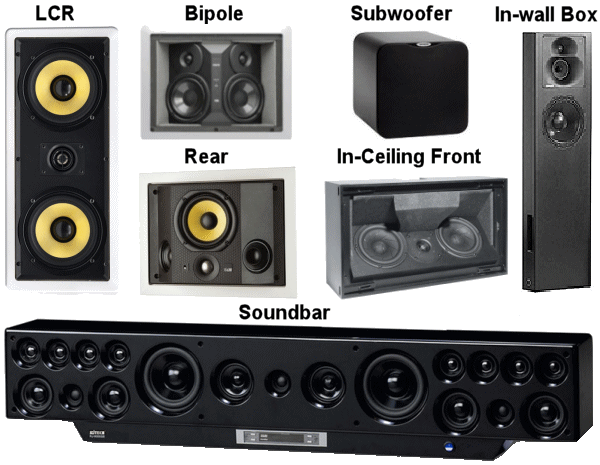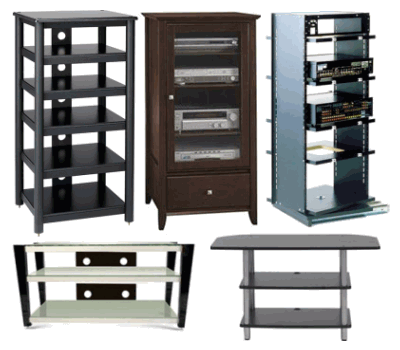Home Theater Setup
- the location of the television
- is the TV wall mounted, part of an entertainment center, over the fireplace...
- the number of speakers
- the locations/positions of those speakers
- are the speakers in-wall, wall mount, book shelf, or floor standing
- the location of the stereo components and other electronics
Television
There usually aren't many choices on where to place the television, especially if it is a flat panel that you are hanging it on the wall. If possible, you will want to place it where the sun will not shine directly on it. The center of the TV should be eye level when you are sitting down. If hanging the TV above the fireplace or some other high location, then get an angled wall mount so that you can tilt the TV downward. Also, placing the TV in the corner of the room makes it very difficult to place speakers for surround sound.If this is a wall mount installation, then be sure to have a power outlet and audio/video cables behind where the TV will be mounted. For audio/video cables for a new HDTV, I would suggest at least:
- 2 or 3 HDMI cables for a cable/satellite HDTV signal, a Blu-Ray player, and possibly a game system like an Xbox 360 or a PS3. Some TVs also take a computer VGA or DVI input, although DVI can be converted into HDMI so a separate cable may not be required.
- 2 S-Video or component cables for legacy devices like a DVD player, VCR, or an older game system
- Composite and/or digital optical audio cables to go with the S-Video input
Although it is possible to make HDMI cables from Cat5 or other wire, you will get the best quality if you run a wire directly from the stereo component right to the TV without any breaks in the wire for a wall plate. It won't look as good to have a hole in the wall with a wire coming out of it, but this hole should be hidden by the TV and there will be a lot less signal loss.
If this is a TV in an entertainment center or on top of a TV stand with all of the stereo components with it, then you don't need to run any of the wires from the components to the TV. You will have to run speaker wires and other wires in-wall. This is covered in the Stereo Components section below.
Speakers
Once you have chosen the location for your TV, you will need to place the speakers. Placement is determined first by the number of speakers. Receivers, amplifiers, and surround sound processors usually indicate the number of speakers as 5.1, 6.1, or 7.1. The .1 refers to the single subwoofer channel. Some systems may have 2 subwoofer channels or two center channels, but these are the basic configurations.| Channels | Description |
|---|---|
| 5.1 | One center, Two fronts, Two side/rear |
| 6.1 | One center, Two fronts, Two side, One rear |
| 7.1 | One center, Two fronts, Two side, Two rear |
Click image for larger view

For home theater, all speakers should be at ear height when seated. This will not be possible for the center channel, since that is where the TV is placed. Some systems resolve this by using 2 center channels placed on either side of the TV or above and below the TV. This isn't really necessary. You can just place a single center channel above or below the TV.
Windows, hallways and open rooms may interfere with perfect speaker placement. If perfect placement is not possible, it is best that pairs of speakers be placed consistently. If one side speaker needs to be close to the corner, then place both of them near the corner.
Types/Categories of Home Theater Speakers
Some additional speaker terms as they apply to home theater.Bipole/Dipole: A speaker that uses two sets of drivers to generate sound both forward and backward, or side to side, to create a full diffuse sound field. With bipole speakers the two sounds are "in phase." With dipole speakers the two sounds are "out of phase." In a home theater setup bipole speakers are better behind the listener at the back of the room, and dipoles are better when placed at the side of the listener on the sides of the room. Some speakers have switches that allow them to operate in both bipole and dipole modes.
LCR: Stands for Left-Right-Center, these speakers can be used as main, surround, or center speakers. Some believe that all 5+ speakers in a home theater system should not only be matched but should be identical. LCR speakers are designed for this purpose.
Full Range: These speakers cover the full (or almost full) range of audible frequencies (20 - 20,000 Hz). Full range speakers are usually comprised of 3 or more drivers and are often floor standing.
Bookshelf: As the name indicates, these speakers are small enough to fit on a bookshelf, although they usually sit on speaker stands. They are typically not full range and usually contain 2 drivers: a tweeter and a midrange driver.
Soundbar: A short wide speaker intended to be mounted right above or below a flat screen television. Many flat panel TVs have thin speakers that aren't capable of loud volumes. Sometimes adding just a sound bar will overcome this problem.
On-wall: Many speakers are designed to be placed at least a foot away from the wall. Speakers that are close to the wall can have too much bass and will have reflection problems with sounds bouncing off the wall. If you are looking to mount speakers on the wall or very close to the wall, make sure they are specifically designed for it.
In-wall: These are speakers that are placed inside the wall between the studs. Instead of using a speaker cabinet, the area inside the wall is the speaker box. These speakers work for varied "chamber" sizes since ceiling height and the distance between studs can vary.
In-wall Box: In wall speakers that still have a speaker box. The speaker box must fit in a wall between studs, which means 3.5" deep and 14.5" wide. If these speakers are used on an exterior wall, then you lose the insulation in that wall.
In-ceiling: Similar to in-wall speakers, these are mounted in the ceiling. These speakers usually aim directly down and do not make good home theater speakers, but there are in-ceiling speakers where the drivers are angled toward the listener.
Shielded: Speakers that are magnetically shielded so that they will not interfere with your TV. A non-shielded speaker placed next to a CRT TV can permanently damage it.
Center: A speaker specifically designed as the center channel in Home Theater system. These should be placed directly above or below the TV - with 2 centers they can be placed on the sides of the TV. A center channel speaker plays the action visible on the TV which is usually voices.
Front: Speakers designed specifically as the front speakers in a Home Theater system.
Rear: Speakers designed specifically as the rear speakers in a Home Theater system. Sometimes these speakers aren't directed toward the listener and instead fill the rear of the room with sound.
Subwoofer: A special speaker designed to produce the low bass frequencies, typically below 150 Hz or lower. A subwoofer can sometimes make up for the fact that that bookshelf speakers cannot produce the lower bass frequencies. Subwoofers usually have their own built in amplifier and crossover.
Here are some samples of in-wall speakers

Stereo/TV Cabinets
Your TV placement will dictate your options for a stereo cabinet to hold your components. If your TV is sitting on a stand, then you are already set. Your stereo and TV components (satellite/cable receiver, DVD/Blu-Ray player...) will most likely be placed in that stand. With a wall mounted flat panel you have a couple of options. You will still need some cabinet to hold your components, but you have a lot of flexibility in the placement for that cabinet: next to the TV, in the corner of the room, in the room behind the the TV, in the room below the TV... If the components are in a different room you will need a IR repeater so that the remote will still work.